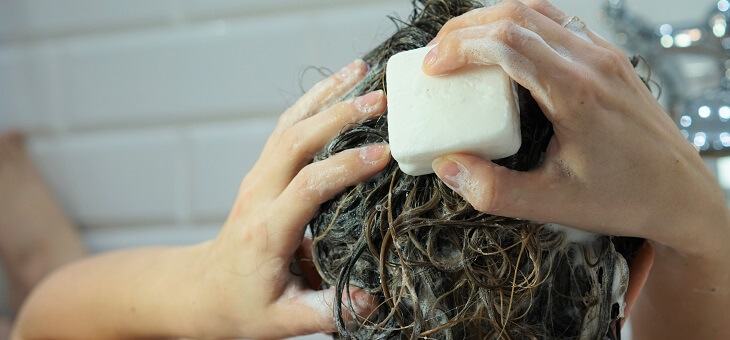As someone with a multi-step skin and hair routine, I often feel uncomfortable at the amount of waste involved.
I try to cut down as much as possible – opting for eco-friendly brands and choosing glass over plastic when I can – but it’s not always that easy. Hair is a particularly tricky area to be sustainable, as so many products are in plastic bottles that need replacing regularly.
That’s why I was keen to try shampoo bars. These replace your normal liquid shampoo, and look just like a bar of soap. They do away with a whole lot of plastic packaging – plus, they take up a tiny amount of space in your shower.
Shampoo bars are slowly but surely growing in popularity – Lush has sold 38 million naked shampoo bars globally since 2007, which the company says has eliminated over 90 million plastic bottles. Previously more of an underground product, bars are now hitting the mainstream, with big brands such as Garnier bringing out their own.
So, how do shampoo bars actually work, and can they give your hair the same shine with less of an environmental footprint?
Read: Is it bad to wash your hair in the bath?
How does it work?
According to hair expert Anabel Kingsley, there’s not a great deal of difference between solid and liquid shampoos. “The job of a shampoo is to cleanse the scalp, and both will do so effectively,” she says.
“The type of product would not necessarily impact its effectiveness, it would be dependent on its ingredients,” explains Ms Kingsley. “A well formulated liquid shampoo is going to be better than a terribly formulated shampoo bar, and vice versa.”
So, what do you need to know?
View this post on Instagram
If you’re thinking of making the switch from liquid to solid, it’s worth doing a bit of research. “You should definitely consider the ingredients and whether they are suitable for your hair type and texture,” says Ms Kingsley.
“For example, someone with fine or oily hair would want to avoid a bar with oils, whereas someone with coiled curls or very dry hair would want to avoid a bar that was drying.”
For fine hair, Ms Kingsley recommends looking out for shampoos with thickening proteins – such as cellulose or keratin – and for coarse, curly hair, she says: “Go for formulas containing moisturising agents, such as cocoa butter.”
Why should you make the switch?

The environmental arguments for swapping out plastic bottles for sustainable bars are pretty compelling. Approximately 373 million plastic water bottles end up as waste each year in Australia, as only 36 per cent of plastic drink bottles are being recycled. Although the majority of plastic bottles are recyclable, the vast majority end up in landfill where they can take up to 1000 years to break down.
“The rest pollute our oceans or lead to a rise in CO2 emissions when incinerated or dumped in landfills,” says Joy Parkinson, managing director of beauty brand Faith In Nature (faithinnature.co.uk).
She calls shampoo bars – particularly ones with recyclable packaging – “a more sustainable way of reducing waste in our beauty care regime”.
All this, and it’s ideal for travelling, shampoo bars mean no more unwanted leaks in the suitcase.
Read: The dos and don’ts of ageing hair
How did I find it?
View this post on Instagram
I was initially sceptical of how well a shampoo bar would work. I’ve got quite a lot of hair and always end up using a fair amount of product to make sure it’s all clean – not to mention I was washing it a whole lot less in lockdown, so when I did finally get around to using shampoo, my hair was definitely in need of a good clean.
I tried the Nuddy Daily Shine Treatment Shampoo Bar in Mint, Lime and Grapefruit, which has a delightfully tropical scent. I was surprised at how well it lathered – I was expecting something similar to a bar of soap, but rubbing this bar in between your hands gets you a lot more product.
Other than lathering, it’s exactly like washing my hair with liquid shampoo, and I’m pleased with the shine it gave my locks.

However, I have found my hair getting greasier more quickly than normal, but I’m chalking this up to over-enthusiastic lathering. It’s quite hard to know how much of the product you’re actually using with a bar, but I imagine this is something I’ll get used to over time.
In the longer term, it will be interesting to see how well it protects the colour in my hair, and I’m curious how many washes I’ll be able to get out of one bar. For now, I’m delighted with the results, and think it’s an easy way to cut down on plastic in my beauty routine. Maybe it’s time I started looking into solid conditioner, too?
Read: How companies are fighting food waste
Keen to try it yourself?

Faith In Nature Shampoo Bar, $14

Garnier Ultimate Blends Coconut Hydrating Shampoo Bar with Aloe Vera for Normal Hair, $16, ASOS

Foamie Coconut Shampoo Bar, $12, Care to Beauty

Lush Honey I Washed My Hair Shampoo Bar, $16.95
– With PA
If you enjoy our content, don’t keep it to yourself. Share our free eNews with your friends and encourage them to sign up.

